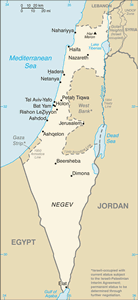The Geography of Israel
The Geography of Israel
Israeli Geography
Location: Middle East, bordering the Mediterranean Sea, between Egypt and Lebanon
Geographic coordinates: 31 30 N, 34 45 E
Map references: Middle East
Area: total: 20,770 sq km land: 20,330 sq km water: 440 sq km
Area - comparative: slightly smaller than New Jersey
Land boundaries: total: 1,017 km border countries: Egypt 266 km, Gaza Strip 51 km, Jordan 238 km, Lebanon 79 km, Syria 76 km, West Bank 307 km
Coastline: 273 km
Maritime claims: territorial sea: 12 nm continental shelf: to depth of exploitation
Climate: temperate; hot and dry in southern and eastern desert areas
Terrain: Negev desert in the south; low coastal plain; central mountains; Jordan Rift Valley
Elevation extremes: lowest point: Dead Sea -408 m highest point: Har Meron 1,208 m
Natural resources: timber, potash, copper ore, natural gas, phosphate rock, magnesium bromide, clays, sand
Land use: arable land: 15.45% permanent crops: 3.88% other: 80.67% (2005)
Irrigated land: 1,940 sq km (2003)
Natural hazards: sandstorms may occur during spring and summer; droughts; periodic earthquakes
Environment - current issues: limited arable land and natural fresh water resources pose serious constraints; desertification; air pollution from industrial and vehicle emissions; groundwater pollution from industrial and domestic waste, chemical fertilizers, and pesticides
Environment - international agreements: party to: Biodiversity, Climate Change, Climate Change-Kyoto Protocol, Desertification, Endangered Species, Hazardous Wastes, Ozone Layer Protection, Ship Pollution, Wetlands, Whaling signed, but not ratified: Marine Life Conservation
Geography - note: there are about 340 Israeli civilian sites - including 100 small outpost communities in the West Bank - as well as 42 sites in the Golan Heights, 0 in the Gaza Strip, and 29 in East Jerusalem (July 2008 est.); Lake Tiberias (Sea of Galilee) is an important freshwater source


